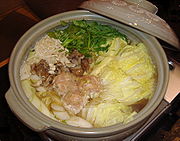- Nabemono
-
Nabe (cuisine)
 Pour les articles homonymes, voir Marc-Édouard Nabe.
Pour les articles homonymes, voir Marc-Édouard Nabe. Nabe, au style de Kansai
Nabe, au style de Kansai
Le nabe ou nabemono (casserole en traduction littérale) est un mets familial de l'hiver au Japon. Le nabe représente plus un concept qu'une recette. En français, on traduirait cela par fondue.
Chauffé par un réchaud sur la table, on prépare une soupe — la plus simple étant juste de l'eau, souvent avec du bouillon de poisson, ou konbu (algues séchées) — dans une grande marmite, où de multiples ingrédients seront plongés petit a petit.
Les ingrédients sont très variés, même si on y retrouve souvent : du chou chinois, kuzukiri, (nouilles de kuzu, transparentes), du tofu, itokonnyaku ou shirataki (vermicelles blancs de konjac), kinoko (champignons), du poisson, des huîtres, et de fines tranches de viandes (bœuf, porc).
À la fin, on peut faire avec la soupe restante, de l'ojiya, avec du riz pré-cuit, un œuf et du negi haché menu (petits poireaux japonais ou ciboulette).
Voir aussi
- Portail de l’alimentation et de la gastronomie
- Portail du Japon
Catégorie : Cuisine japonaise
Wikimedia Foundation. 2010.

